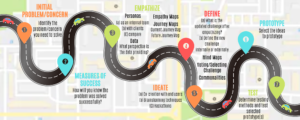Welcome to the fifth and final phase of the design thinking journey, test! This phase occurs when you are ready to let users take the wheel and test drive your solution. Don’t try to skip out on the test phase. It may uncover crucial aspects about the problem or the solution that users have not yet been able to articulate – so encourage users to provide detailed feedback about what they liked or didn’t like about all of the options tested. Carefully observe how they interact with the product or service physically. Try to make the testing environment as neutral as possible by holding the test in an environment similar to the one they would be using the solution in real life or role-playing. If they are going to use it in a busy and noisy environment, test the prototypes in busy and noisy environments. Your goal is to encourage spontaneous and authentic reactions from users.
The design team needs to take the back seat at this stage. They should withhold their questions until the test is complete and simply observe how users interact with the product or service independently. After the user has completed the test, feel free to follow up using any questions you may have come up with during the test. Have questions pre-prepared for the test phase to ask after observing the users. This is your opportunity to validate what you have learned about your users and how you have applied that knowledge to solve their problems. When it comes to testing, don’t be afraid of negative feedback. It is better to learn what didn’t work about your solution early on and why – so you don’t waste time further down the road when you implement the solution in the real world. Through testing (and failing) quickly, you can return to any of the design process steps and reiterate towards a better solution that users will love.
Spring2 Innovation teaches learners A/B testing – an excellent technique for comparing two versions of a product or service. In A/B testing, both designs are identical except for one variation that might affect a user’s behavior. For example, version A might be the design currently being used (the control design), while version B is modified in some respect (treatment). Through A/B testing, you can isolate certain variables that may affect your design’s performance and improve in the next iteration.

Similar to prototyping, it can be discouraging when a test didn’t yield the result you were expecting, especially when lots of hard work has gone into that iteration. As difficult as it is, failure is bound to the design process, and there is no shame in a failed test. If something doesn’t turn out the way you planned, determine what this information is telling you. Observe, record, and return to a previous phase to tease out what happened. If your test yields an unfavourable result, you have still gained essential information at a point in the project where it is possible to return to the drawing board. The design thinking process is all about discovery, which can happen at any of the five phases of the process. Adapting to new information and experiences is key to innovation.
For more information on testing, check out Spring2 Innovation’s YouTube channel:
As part of Spring2 Innovation’s Design Thinking Certificate, we teach you how to master all five phases of the Design Thinking methodology. We teach learners how to apply design thinking tools and methodologies from a solution-based lens with the end-user in mind.

